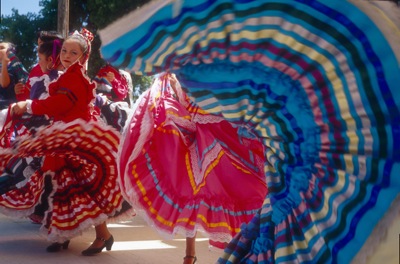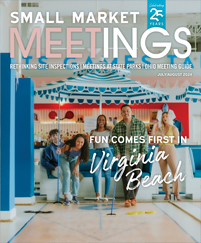 By MarkKane.net, courtesy Santa Fe CVB
By MarkKane.net, courtesy Santa Fe CVB
A funny thing happened to a meeting planner on her way to the Santa Fe Community Convention Center. She followed the directions she was given for the five-minute walk from her hotel, but when she arrived at the appointed address in Santa Fe’s a, she saw nothing that resembled a traditional convention center.
“I followed the directions,” she told others later, ”but all that was there was a big adobe building.”
That building was the convention center, designed to fit into the Pueblo architecture that is dominant in the blocks near the one-block square known as the Plaza, Santa Fe’s historic heart.
Holding on to its history
The country’s second-oldest city is determined to hold fast to its sense of place; the convention center is a new example of its success at doing so.
“It is quite a nice building, and from the outside, it is not obviously a convention center,” said Andrew Kraynik, a New Mexico resident who has helped plan two conferences in Santa Fe for the Society of Rheology.
The new center opened in 2008, and although it was built on the same footprint as its predecessor, the parallels between the two structures end there.
The former convention center “was really nothing more than a 10,000-square-foot gymnasium,” said Keith Toler, executive director of the Santa Fe Convention and Visitors Bureau. He also oversees the city-owned convention center.
Despite the previous center’s limitations, conferences were determined to go to Santa Fe. Carol Kuc, president and CEO of Complete Conference Coordinators, has planned a number of conferences there over the last 25 years. Among them was a conference for physicists that used the old building and last fall, for the first time, the new one. “The old facility was not workable many times for us, but the scientists loved Santa Fe,” said the Chicago-area meeting planner.
The new convention center has further elevated this high-desert destination.
“That [the new convention center] was powerful change,” said Kuc.
Its 29,000 square feet of indoor meeting space includes an 18,000-square-foot ballroom and 10 breakout rooms. Outdoor escapes are plentiful, 10,000 square feet worth among terraces and a large courtyard.
The facility has made the city of 70,000 a possibility for conferences that couldn’t physically fit there in the past.
“We had never had a meeting in Santa Fe before because it wasn’t a big enough area,” said Bob Tacker, executive director for New Mexico Technology in Education. “We have around 400 attendees and 65 to 70 vendors.”
Large groups need multiple hotels
In Santa Fe, larger conferences must be housed in multiple hotels, most within walking distance of the convention center in Santa Fe’s compact downtown, a National Historic District.
For meetings of 500 to 800, that could mean using a half-dozen properties, but meeting planners don’t seem to mind, nor do attendees.
“We had a nice range of hotels, six right in downtown and another small motel on the outskirts for graduate students and those on a budget,” said Kraynik. “Not having a convention center hotel is not a problem as far as I am concerned.”
Kuc’s 800 meeting attendees were housed in five hotels, and like Kraynik, she chose properties with different price points.
The 158-room Hilton Santa Fe, a block from the Plaza, is often used as the headquarters hotel. It is the only hotel downtown that is a national chain although there are many flagged properties on the city’s outskirts.
In addition to the Hilton, Kuc’s group used the recently renovated 219-room Eldorado Hotel, a AAA Four Diamond property with 20,000 square feet of meeting space, and the 167-room La Fonda on the Plaza, opened in 1922 as one of the famous Harvey Hotels, which were stationed along the railroad tracks that brought people west.
La Fonda is a longtime favorite
“The La Fonda is Santa Fe’s most historic hotel,” said Annadru Lampert, director of sales. “There has been a hotel on this corner for 400 years continuously.”
The hotel remains in the hands of the local family that has owned it since 1968. They regard themselves as its conservators.
During a recent redo of the hotel’s restaurant, the refrain “What would Mary Jane do?” was repeated frequently, a reference to Mary Jane Colter, the 1920s designer credited with giving the hotel its lively and distinctive decor.
“We didn’t want to move too far away from who we were,” said Lampert. “Our biggest selling points are our location and our decor. Here you have the feeling that you are having an authentic experience at an unusually beautiful hotel. It feels like you can’t separate the hotel from Santa Fe.”
Other popular properties that fit their Southwestern locale are the Hotel St. Francis, an 80-room inn one block from the Plaza; the 134-room Inn and Spa at Loretto, built on the site of a Catholic girls school; and the 56-room boutique Hotel Plaza Real.
Santa Fe’s distinctiveness extends to its off-site meeting places, which include some of its 10 museums. For example, both Koc and Kraynik have used the New Mexico History Museum and the adjacent Palace of the Governors for large receptions.
The history museum opened in 2009; the Palace of the Governors is, at 400, the oldest public building still in continuous use in the United States.
“You have one space that is very historic and an actual artifact, and in contrast to that a brand-new contemporary building that is the museum,” said Inessa Williams, event coordinator. “They are two contrasting spaces and are very special in their own right.”
The history museum’s lobbies are bathed in light from its windows and glass walls. In addition to exhibit areas, the museum has an auditorium that seats 210 people and a rooftop terrace that overlooks downtown and the Plaza.
The Georgia O’Keeffe Museum, housed in an old adobe church one block from the Plaza, is a small museum with large impact in the the world of art.
It opened in the mid-1990s, 11 years after the death of the American abstractionist, who lived in Santa Fe almost four decades.
O’Keeffe did her part to promote Santa Fe and New Mexico, by painting dramatic works that seem almost unbelieveable in their beauty.
“The one thing about Georgia O’Keeffe is that she is one of the artists — the few in the world — who is so related to place,” said Christina Dallorso Kortz, visitor relations manager. “I thought her works were highly abstracted until I moved to New Mexico and saw the areas she painted. It [the landscape] was precisely like that.”
The museum’s galleries and courtyard suit groups of 150 or fewer. For larger events, the museum offers its research center lawn.
Outdoor gatherings in season
“It is a garden oasis right in the middle of downtown Santa Fe,” Kortz said. “In the last year, we’ve received funding to redesign the garden area, and the plantings you will see are plantings that O’Keeffe either painted or grew.”
Gathering outdoors is a popular in Santa Fe, an idea enhanced by a wealth of courtyards and plazas.
The convention center staff has used the convention center’s plazas for some out-of-the-ordinary coffee breaks, according to Toler. It has invited Native American and other artists to set up displays under tents in the courtyards, giving attendees the chance to do some shopping on their breaks.
Outdoor events are seasonal, however, because even though it is frequently sunny in Santa Fe, the winter days can be cold.
In addition to its architecture, Santa Fe is also known for its ability to whet appetites. At the convention center, the staff has helped groups work with local restaurants to organize tastes of Santa Fe.
To add Santa Fe flavor to his conference, Kraynik hired Walter Burke Catering, the company he used when he planned the rheology conference in Santa Fe some 20 years ago.
The longtime Santa Fe caterer is known for food that fits the city, from brunch burritos with Spanish chorizo and red and green chilies, to empanaditas filled with ropa vieja or juniper-marinated bison served on brioche toast.
Nowhere is food more fun than at the Santa Fe School of Cooking, in business for 21 years, just off the Plaza. There, groups can get the hang of making homemade tortillas, tamales and other indigenous dishes.
Groups of 30 or so can split into teams and make dishes that become a meal for the entire group. “In everything we do, we try to give a sense of place,” said the school’s Nicole Ammerman. “Here in Santa Fe, we have a unique cultural history. We celebrate that local flavor.”
More on Santa Fe











